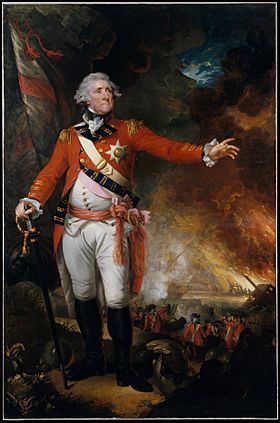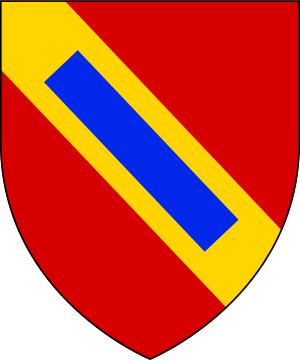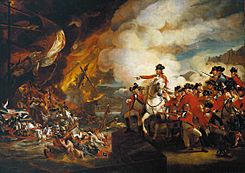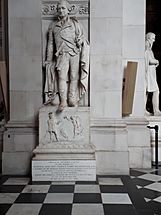George Augustus Eliott, 1st Baron Heathfield facts for kids
Quick facts for kids
The Lord Heathfield
|
|
|---|---|

1787 portrait by
Sir Joshua Reynolds |
|
| Governor of Londonderry | |
| In office 1774–1775 |
|
| Governor of Gibraltar | |
| In office 1777–1790 |
|
| Personal details | |
| Born | 25 December 1717 Wells House, nr Stobs, Roxburghshire, Scotland |
| Died | 6 July 1790 (aged 72) Schloss Kalkofen, Aachen, Germany |
| Resting place | St Andrew's Church, Buckland Monachorum, Devon |
| Spouse |
Anne Pollexfen Drake
(m. 1748; died 1772) |
| Children |
|
| Parents | Sir Gilbert Eliott, 3rd Baronet, of Stobs and Eleanor Elliot |
| Awards | |
| Military service | |
| Allegiance | |
| Branch/service | |
| Battles/wars |
|
George Augustus Eliott, 1st Baron Heathfield (born December 25, 1717 – died July 6, 1790) was a brave Scottish officer in the British Army. He fought in three big wars during the 1700s. He became famous during the Seven Years' War for fighting in Germany. He also helped in British attacks on Belle Île in France and Cuba. Eliott is most remembered for leading the soldiers in Gibraltar during the Great Siege of Gibraltar. This long siege lasted from 1779 to 1783, during the American War of Independence. He was celebrated for successfully defending the fortress against Spanish and French attackers.
Contents
A Brave General's Life
Early Years and Training
George Eliott was born at Wells House in Scotland. He was one of many children of Sir Gilbert Eliott. His family had a history of military service.
He went to school at the University of Leiden in the Netherlands. He also studied military subjects like artillery in France. Before joining the British Army, he served with the Prussian Army for a short time.
In 1741, Eliott joined the Engineers, a special group that designs and builds military structures. He later joined the 2nd Troop of Horse Grenadier Guards. He fought in the War of Austrian Succession from 1742 to 1748. He was wounded at the Battle of Dettingen and also fought at the Battle of Fontenoy.
Fighting in Major Wars
Eliott became a Colonel in the army. He served as an assistant to King George II. In 1758, he was put in charge of a special cavalry group. He was very good at leading his soldiers.
He showed great courage in Germany during the Battle of Minden in 1759. He was promoted to Major-General. He also fought well in the 1760 Battle of Emsdorf.
Eliott helped capture Belle Île in 1761. He was second-in-command when the British captured Havana in Cuba in 1762. For this success, he received a lot of money. He used some of it to buy a large estate in England. He became a Lieutenant-General in 1765.
The Great Siege of Gibraltar
On May 25, 1777, Eliott became the Governor of Gibraltar. Gibraltar is a very important fortress at the entrance to the Mediterranean Sea. He was promoted to General in 1778.
In July 1779, the French and Spanish armies began a long attack on Gibraltar. This was called the Great Siege of Gibraltar. Eliott used his engineering skills to make the fortress even stronger. The Spanish tried to starve the soldiers inside. The siege lasted for a very long time, until 1783.
Eliott was known for his simple lifestyle. He ate mostly vegetables, biscuits, and water. He also slept only about four hours a night.
On September 13, 1782, the French and Spanish launched a huge attack. They had 100,000 men, 48 ships, and 450 cannons. But Eliott and his soldiers held their ground. They bravely defended Gibraltar. By 1783, the siege was finally ending.
The British Parliament thanked Eliott for his amazing defense. He was made a Knight of the Bath. The siege officially ended on February 6, 1783.
Later Life and Legacy
Eliott returned to England in 1787. He was given the title of Lord Heathfield, Baron Heathfield of Gibraltar. Many statues, portraits, and even coins were made to honor him.
He was formally made a Knight of the Bath in 1788. Around this time, he was traveling back to Gibraltar. However, he became ill in Germany. He stayed in the Aachen area to get better.
Eliott passed away on July 6, 1790, in Aachen, Germany. He was first buried there. Later, his body was moved and reburied in England.
Personal Life
George Eliott was a vegetarian. People said he "never touched strong liquor or meat, but lived chiefly on vegetables, simple puddings, and water."
He married Anne Pollexfen Drake in 1748. They had two children:
- Francis Augustus Eliott, who became the 2nd and last Baron Heathfield.
- Anne Pollexfen Eliott, who married John Trayton Fuller and had many children.
Remembering General Eliott
General Eliott is still remembered today. His picture has been on the £10 Gibraltar pound banknotes since 1995.
Many famous artists painted his portrait. These include Sir Joshua Reynolds, John Singleton Copley, and John Trumbull. Their paintings are in famous museums like the National Gallery and the Metropolitan Museum of Art.
There is a large marble statue of him in St Paul's Cathedral in London. A bust (a sculpture of his head and shoulders) of Eliott is in the Gibraltar Botanic Gardens. There are also pubs in England named after him.
He is even mentioned in a poem by the famous Scottish poet Robert Burns. This shows how inspiring he was to people.
Images for kids
-
Defeat of the floating batteries by John Singleton Copley - This painting shows the climax of the Great Siege of Gibraltar in 1782. Eliott is on the white horse.
-
Memorial by John Bacon, senior in St Andrew's Church, Buckland Monachorum.
-
Memorial to Eliott, by Charles Rossi in St. Paul's Cathedral, London.
See also
- Governors of Gibraltar
- Drake baronets
- George Augustus Eliot (1784-1835), British and Canadian Army officer







